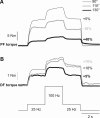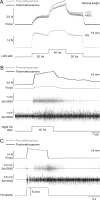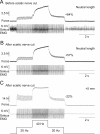Extra forces evoked during electrical stimulation of the muscle or its nerve are generated and modulated by a length-dependent intrinsic property of muscle in humans and cats
- PMID: 21490198
- PMCID: PMC4115248
- DOI: 10.1523/JNEUROSCI.6641-10.2011
Extra forces evoked during electrical stimulation of the muscle or its nerve are generated and modulated by a length-dependent intrinsic property of muscle in humans and cats
Abstract
Extra forces or torques are defined as forces or torques that are larger than would be expected from the input or stimuli, which can be mediated by properties intrinsic to motoneurons and/or to the muscle. The purpose of this study was to determine whether extra forces/torques evoked during electrical stimulation of the muscle or its nerve with variable frequency stimulation are modulated by muscle length/joint angle. A secondary aim was to determine whether extra forces/torques are generated by an intrinsic neuronal or muscle property. Experiments were conducted in 14 able-bodied human subjects and in eight adult decerebrate cats. Torque and force were measured in human and cat experiments, respectively. Extra forces/torques were evoked by stimulating muscles with surface electrodes (human experiments) or by stimulating the nerve with cuff electrodes (cat experiments). In humans and cats, extra forces/torques were larger at short muscle lengths, indicating that a similar regulatory mechanism is involved. In decerebrate cats, extra forces and length-dependent modulation were unaffected by intrathecal methoxamine injections, despite evidence of increased spinal excitability, and by transecting the sciatic nerve proximal to the nerve stimulations. Anesthetic nerve block experiments in two human subjects also failed to abolish extra torques and the length-dependent modulation. Therefore, these data indicate that extra forces/torques evoked during electrical stimulation of the muscle or nerve are muscle length-dependent and primarily mediated by an intrinsic muscle property.
Figures











Similar articles
-
Plantar flexion force induced by amplitude-modulated tendon vibration and associated soleus V/F-waves as an evidence of a centrally-mediated mechanism contributing to extra torque generation in humans.J Neuroeng Rehabil. 2013 Mar 25;10:32. doi: 10.1186/1743-0003-10-32. J Neuroeng Rehabil. 2013. PMID: 23531240 Free PMC article.
-
Vibration-induced extra torque during electrically-evoked contractions of the human calf muscles.J Neuroeng Rehabil. 2010 Jun 10;7:26. doi: 10.1186/1743-0003-7-26. J Neuroeng Rehabil. 2010. PMID: 20537167 Free PMC article.
-
Coordinated, multi-joint, fatigue-resistant feline stance produced with intrafascicular hind limb nerve stimulation.J Neural Eng. 2012 Apr;9(2):026019. doi: 10.1088/1741-2560/9/2/026019. Epub 2012 Mar 14. J Neural Eng. 2012. PMID: 22414699 Free PMC article.
-
Wide-pulse-width, high-frequency neuromuscular stimulation: implications for functional electrical stimulation.J Appl Physiol (1985). 2006 Jul;101(1):228-40. doi: 10.1152/japplphysiol.00871.2005. Epub 2006 Apr 20. J Appl Physiol (1985). 2006. PMID: 16627680
-
A biomechanical perspective on spinal mechanisms of coordinated muscular action: an architecture principle.Acta Anat (Basel). 1994;151(1):1-13. doi: 10.1159/000147637. Acta Anat (Basel). 1994. PMID: 7879588 Review.
Cited by
-
The effects of wide pulse neuromuscular electrical stimulation on elbow flexion torque in individuals with chronic hemiparetic stroke.Clin Neurophysiol. 2012 Nov;123(11):2247-55. doi: 10.1016/j.clinph.2012.04.024. Epub 2012 May 22. Clin Neurophysiol. 2012. PMID: 22627022 Free PMC article.
-
A dynamic calcium-force relationship model for sag behavior in fast skeletal muscle.PLoS Comput Biol. 2023 Jun 8;19(6):e1011178. doi: 10.1371/journal.pcbi.1011178. eCollection 2023 Jun. PLoS Comput Biol. 2023. PMID: 37289805 Free PMC article.
-
Involuntary sustained firing of plantar flexor motor neurones: effect of electrical stimulation parameters during tendon vibration.Eur J Appl Physiol. 2021 Mar;121(3):881-891. doi: 10.1007/s00421-020-04563-7. Epub 2021 Jan 3. Eur J Appl Physiol. 2021. PMID: 33392744 Free PMC article.
-
Effects of three neuromuscular electrical stimulation methods on muscle force production and neuromuscular fatigue.Scand J Med Sci Sports. 2022 Oct;32(10):1456-1463. doi: 10.1111/sms.14210. Epub 2022 Jul 27. Scand J Med Sci Sports. 2022. PMID: 35844045 Free PMC article.
-
Modulation of torque evoked by wide-pulse, high-frequency neuromuscular electrical stimulation and the potential implications for rehabilitation and training.Sci Rep. 2021 Mar 18;11(1):6399. doi: 10.1038/s41598-021-85645-0. Sci Rep. 2021. PMID: 33737664 Free PMC article.
References
-
- Banks RW, Barker D, Stacey MJ. Form and distribution of sensory terminals in cat hindlimb muscle spindles. Philos Trans R Soc Lond B Biol Sci. 1982;299:329–364. - PubMed
-
- Bennett DJ, Hultborn H, Fedirchuk B, Gorassini M. Synaptic activation of plateaus in hindlimb motoneurons of decerebrate cats. J Neurophysiol. 1998a;80:2023–2037. - PubMed
-
- Bennett DJ, Hultborn H, Fedirchuk B, Gorassini M. Short-term plasticity in hindlimb motoneurons of decerebrate cats. J Neurophysiol. 1998b;80:2038–2045. - PubMed
-
- Binder-Macleod SA, Barrish WJ. Force response of rat soleus muscle to variable-frequency train stimulation. J Neurophysiol. 1992;68:1068–1078. - PubMed
Publication types
MeSH terms
Substances
Grants and funding
LinkOut - more resources
Full Text Sources
Miscellaneous
